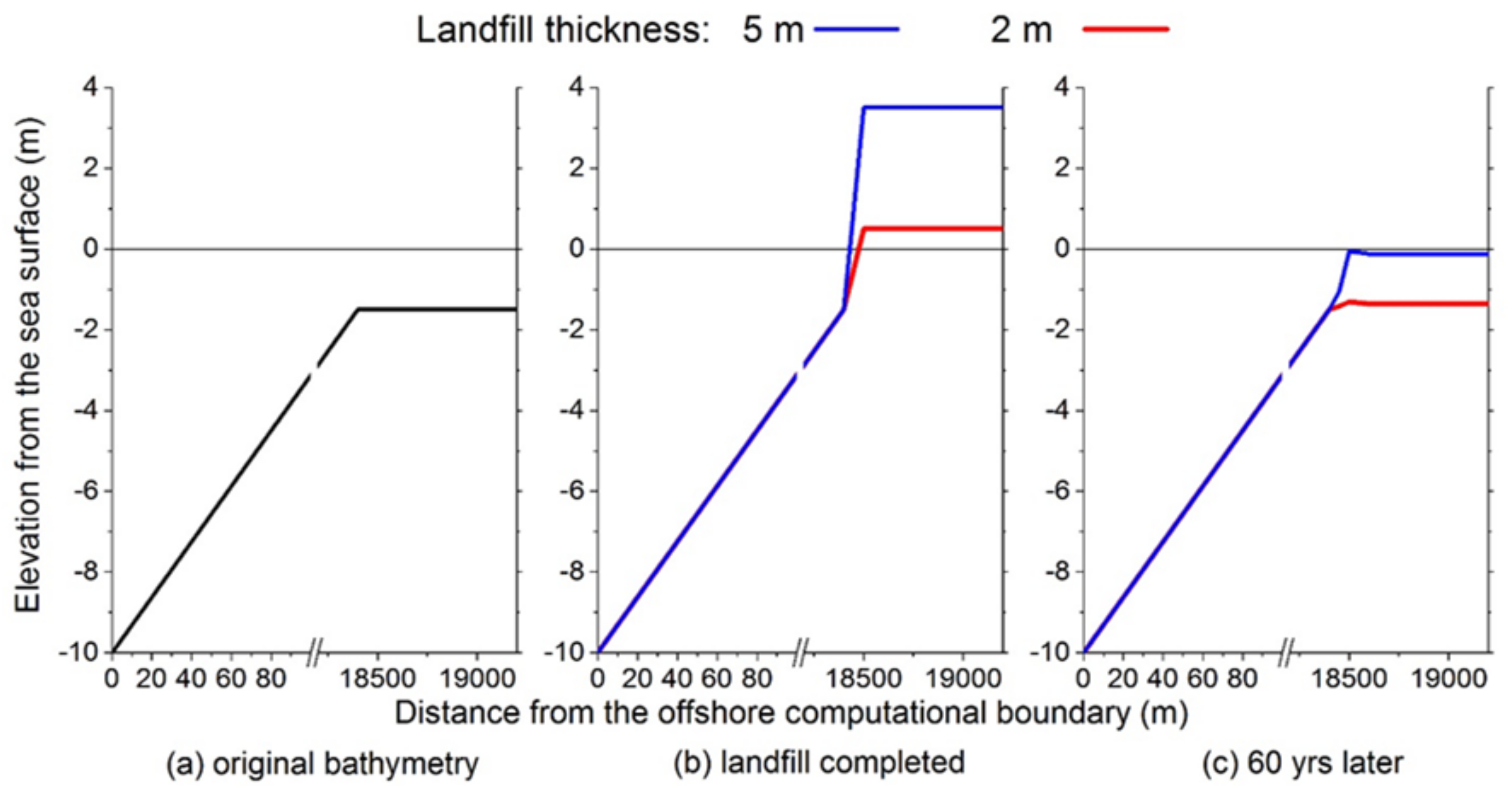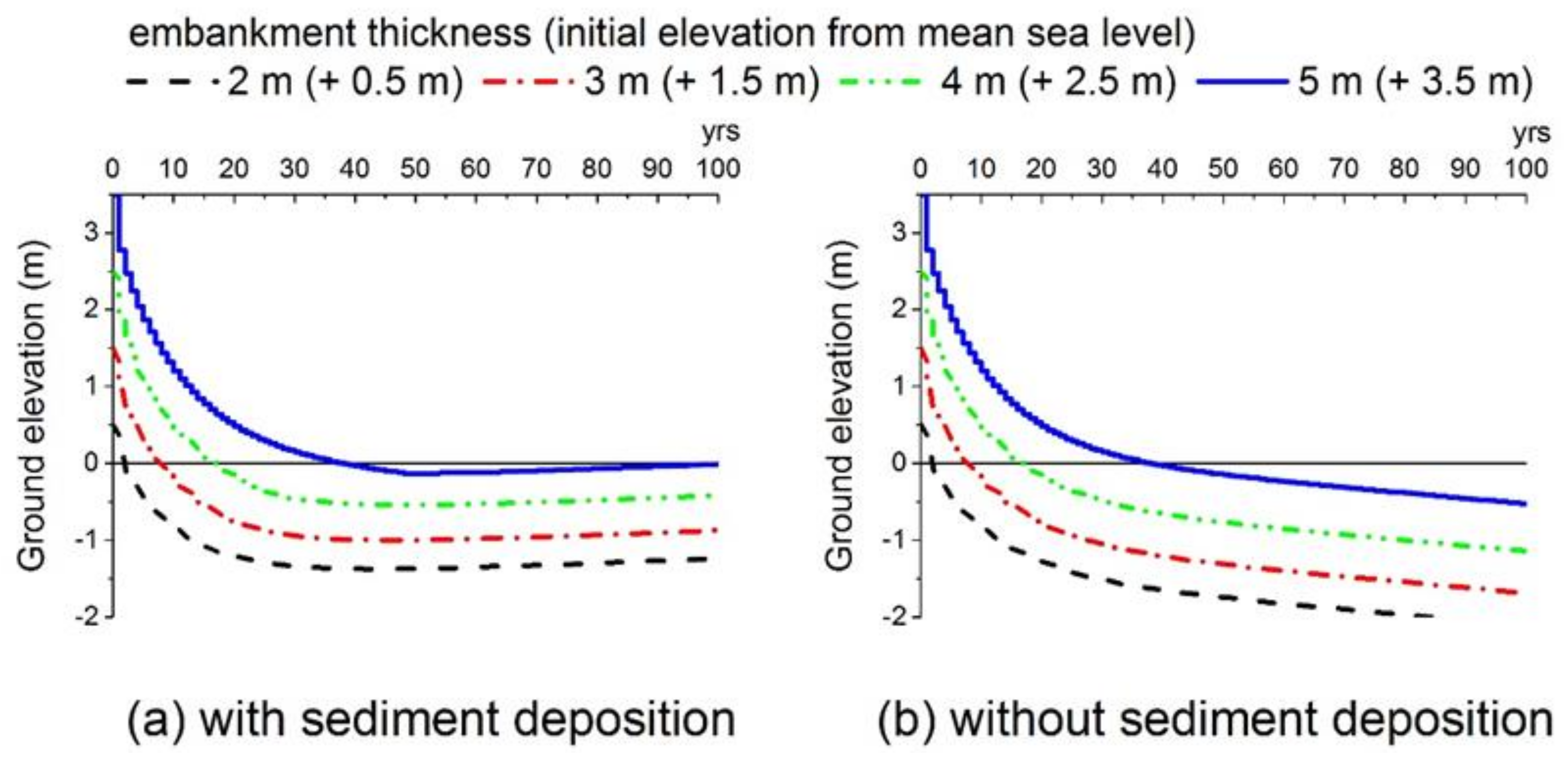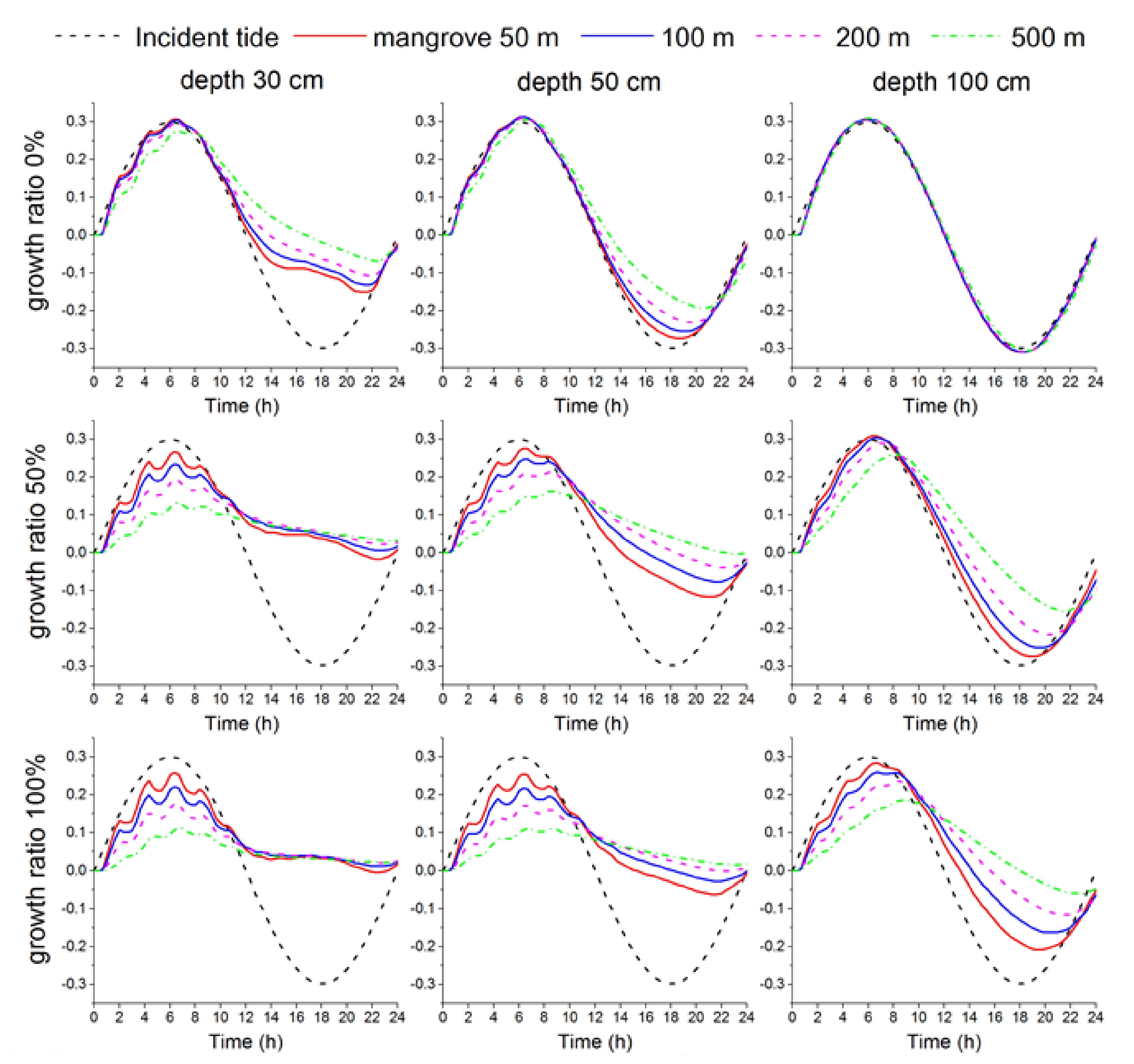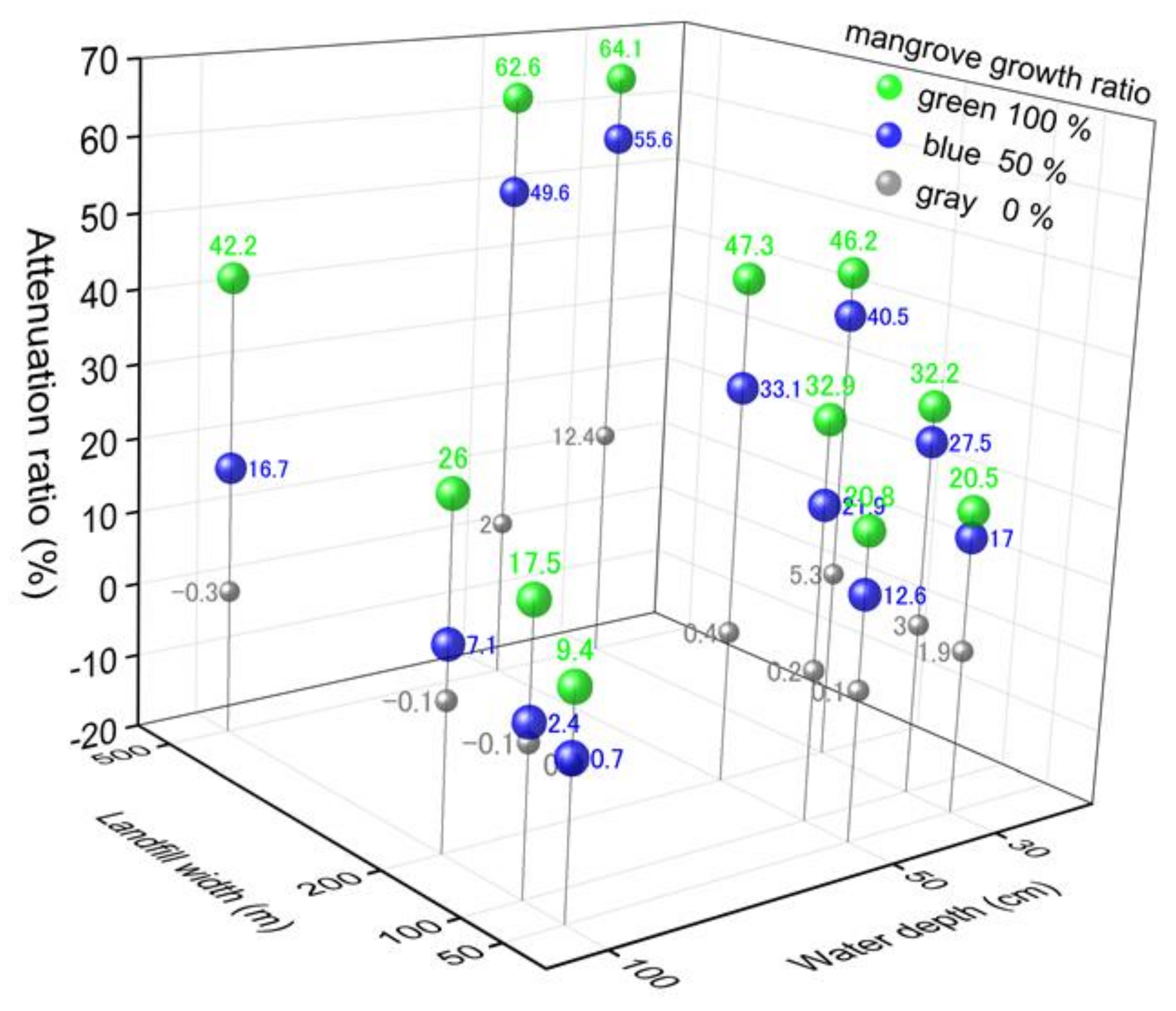Long-Term Design of Mangrove Landfills as an Effective Tide Attenuator under Relative Sea-Level Rise
Abstract
:1. Introduction
2. Methodology
2.1. The Mangrove Landfill Concept
2.2. Long Wave-Consolidation Coupled Modelling
2.3. Resistance of the Mangrove System
2.4. Rate of Sediment Trap
2.5. Conditions Assumed in the Case Study
3. Results
3.1. Ground Elevation over the Lifetime and Tidal Attenuation on the Mangrove Landfill
3.2. Flow Characteristics
4. Discussion
4.1. Mangrove Landfill Must Be Sufficiently High to Avoid a Total Submersion
4.2. Narrow Mangrove Landfills May Not Be Effective
4.3. Mangroves Retain Seawater, Creating Both Positive and Negative Influences
4.4. Enhancing Sediment Deposition
4.5. Fluctuations of Mean-Sea Level
4.6. Diversity of Species
5. Conclusions
Acknowledgments
Conflicts of Interest
References
- Takagi, H.; Mikami, T.; Fujii, D.; Esteban, M. Mangrove forest against dyke-break induced tsunami in rapidly subsiding coasts. Nat. Hazards Earth Syst. Sci. 2016, 16, 1629–1638. [Google Scholar] [CrossRef]
- Vuik, V.; Jonkman, S.N.; Borsje, B.W.; Suzuki, T. Nature-based flood protection: The efficiency of vegetated foreshores for reducing wave loads on coastal dikes. Coast. Eng. 2016, 116, 42–56. [Google Scholar] [CrossRef]
- Tang, J.; Shen, Y.; Causon, D.M.; Qian, L.; Mingham, C.G. Numerical study of periodic long wave run-up on a rigid vegetation sloping beach. Coast. Eng. 2017, 121, 158–166. [Google Scholar] [CrossRef]
- Primavera, J.H.; Esteban, J.M.A. A review of mangrove rehabilitation in the Philippines: Successes, failures and future prospects. Wetl. Ecol. Manag. 2008, 16, 345–358. [Google Scholar] [CrossRef]
- Alongi, D.M. Mangrove forests: Resilience, protection from tsunamis, and responses to global climate change. Estuar. Coast. Shelf Sci. 2008, 76, 1–13. [Google Scholar] [CrossRef]
- Gunderson, L.H.; Holling, C.S.; Pritchard, L., Jr.; Peterson, G.D. Resilience of large-scale resource systems. In Resilience and the Behaviour of Large-Scale Systems; Gunderson, L.H., Pritchard, L., Jr., Eds.; Island Press: Washington, DC, USA, 2002. [Google Scholar]
- Walker, B.; Holling, C.S.; Carpenter, S.R.; Kinzig, A. Resilience, adaptability and transformability in social–ecological systems. Ecol. Soc. 2004, 9, 9. [Google Scholar] [CrossRef]
- Renaud, F.G.; Sudmeier-Rieux, K.; Estrella, M. The Role of Ecosystems in Disaster Risk Reduction, 2013. Available online: http://collections.unu.edu/view/UNU:1995 (accessed on 30 March 2018).
- CNRD-PEDRR Disasters. Environment and Risk Reduction—Eco-DRR Master’s Module, Instructor’s Manual; Center for Natural Resources and Development, Partnership on Environment and Disaster Risk Reduction: Kenya, 2013; 102p, Available online: https://www.preventionweb.net/educational/view/54583 (accessed on 30 March 2018).
- Dosewald, N.; Estrella, M. Promoting Ecosystems for Disaster Risk Reduction and Climate Change Adaptation; Discussion Paper; UNEP: Geneva, Switzerland, 2015; 52p, Available online: http://postconflict.unep.ch/publications/Eco-DRR/Eco-DRR_Discussion_paper_2015.pdf (accessed on 30 March 2018).
- Takagi, H.; Esteban, M.; Mikami, T.; Fujii, D. Projection of coastal floods in 2050 Jakarta. Urban Clim. 2016, 17, 135–145. [Google Scholar] [CrossRef]
- Takagi, H.; Fujii, D.; Esteban, M.; Yi, X. Effectiveness and Limitation of Coastal Dykes in Jakarta: The Need for Prioritizing Actions against Land Subsidence. Sustainability 2017, 9, 619. [Google Scholar] [CrossRef]
- Jamero, M.L.; Onuki, M.; Esteban, M.; Billones-Sensano, X.K.; Tan, N.; Nellas, A.; Takagi, H.; Thao, N.D.; Valenzuela, V.P. Small-island communities in the Philippines prefer local measures to relocation in response to sea-level rise. Nat. Clim. Chang. 2017, 7, 581–586. [Google Scholar] [CrossRef]
- Giosan, L.; Syvitski, J.; Constantinescu, S.; Day, J. Protect the world’s deltas. Nature 2014, 516, 31–33. [Google Scholar] [CrossRef] [PubMed]
- Takagi, H.; Thao, N.D.; Anh, L.T. Sea-level rise and land subsidence: Impacts on flood projections for the Mekong delta’s largest city. Sustainability 2016, 8, 959. [Google Scholar] [CrossRef]
- Krauss, K.W.; McKee, K.L.; Lovelock, C.E.; Cahoon, D.R.; Saintilan, N.; Reef, R.; Chen, L. How mangrove forests adjust to rising sea level. New Phytol. 2014, 202, 19–34. [Google Scholar] [CrossRef] [PubMed]
- Lovelock, C.E.; Cahoon, D.R.; Friess, D.A.; Guntenspergen, G.R.; Krauss, K.W.; Reef, R.; Rogers, K.; Saunders, M.L.; Sidik, F.; Swales, A.; et al. The vulnerability of Indo-Pacific mangrove forests to sea-level rise. Nature 2015, 526, 559–563. [Google Scholar] [CrossRef] [PubMed]
- Sasmito, S.D.; Murdiyarso, D.; Friess, D.A.; Kurnianto, S. Can mangroves keep pace with contemporary sea level rise? A global data review. Wetl. Ecol. Manag. 2016, 24, 263–278. [Google Scholar] [CrossRef]
- Oka, S.; Orishimo, S.; Nagano, A. Natural symbiosis type fishing port rehabilitation using the mangrove (example of the Jakarta fishing port). JSCE Proc. Civ. Eng. Ocean 2004, 20, 1151–1156. [Google Scholar] [CrossRef]
- Munk, W.H. Origin and Generation of Waves. In Proceedings of the First Conference on Coastal Engineering, Long Beach, CA, USA, October 1950; Available online: https://journals.tdl.org/icce/index.php/icce/article/view/904 (accessed on 30 March 2018).
- Kowalik, Z.; Murty, T.S. Numerical Modeling of Ocean Dynamics; World Scientific: Singapore, 1993; p. 481. [Google Scholar]
- Battjes, J.; Labeur, R.J. Unsteady Flow in Open Channels; Cambridge University Press: Cambridge, UK, 2017; p. 299. [Google Scholar]
- Horvath, Z.; Waser, J.; Perdigao, R.A.P.; Konev, A.; Bloschl, G. A Two-Dimensional Numerical Scheme of Dry/Wet Fronts for the Saint-Venant System of Shallow Water Equations. Int. J. Numer. Meth. Fluids 2015, 77, 159–182. [Google Scholar] [CrossRef]
- Dean, R.G.; Dalrymple, R.A. Water Wave Mechanics for Engineers and Scientists; World Scientific Publishing: Singapore, 1984; p. 371. [Google Scholar]
- Roeber, V.; Bricker, J.D. Destructive tsunami-like wave generated by surf beat over a coral reef during Typhoon Haiyan. Nat. Commun. 2015, 6, 7854. [Google Scholar] [CrossRef] [PubMed]
- Wesley, L.D. Fundamentals of Soil Mechanics for Sedimentary and Residual Soils; Wiley: Hoboken, NJ, USA, 2010; p. 431. [Google Scholar]
- Knappett, J.A.; Craig, R.F. Craig’s Soil Mechanics Eighth Edition; CRC Press: Boca Raton, FL, USA, 2011; p. 552. [Google Scholar]
- Osterberg, J.O. Influence values for vertical stresses in a semi infinite mass due to an embankment loading. In Proceedings of the Fourth International Conference on Soil Mechanics and Foundation Engineering, London, UK, 12–24 August 1957; Volume 1, pp. 393–394. [Google Scholar]
- Einstein, H.A. The Bedload Function for Sediment Transportation in Open Channel Flows. Soil Conservation Service U.S. Department Agriculture Technical Bulletin No. 1026. 1950, p. 78. Available online: http://xon.sdsu.edu/einstein_bedload_function.pdf (accessed on 30 March 2018).
- Bagnold, R.A. Mechanics of marine sedimentation. In The Sea; Hill, M.N., Ed.; Wiley: New York, NY, USA, 1963; pp. 507–582. [Google Scholar]
- Dean, R.G. Beach Nourishment: Theory and Practice; World Scientific: Singapore, 2002. [Google Scholar]
- Heathershaw, A.D. Comparisons of measured and predicted sediment transport rates in tidal currents. Mar. Geol. 1981, 42, 75–104. [Google Scholar] [CrossRef]
- Furukawa, K.; Wolanski, E. Sedimentation in mangrove forests. Mangroves Salt Marshes 1996, 1, 3–10. [Google Scholar] [CrossRef]
- Green, J.C. Modelling flow resistance in vegetated streams: Review and development of new theory. Hydrol. Processes 2005, 19, 1245–1259. [Google Scholar] [CrossRef]
- Mazda, Y.; Wolanski, E.; King, B.; Sase, A.; Ohtsuka, D.; Magi, M. Drag force due to vegetation in mangrove swamps. Mangroves Salt Marshes 1997, 1, 193–199. [Google Scholar] [CrossRef]
- Maza, M.; Lara, J.L.; Losada, I.J. Tsunami wave interaction with mangrove forests: A 3-D numerical approach. Coast. Eng. 2015, 98, 33–54. [Google Scholar] [CrossRef]
- Losada, I.J.; Maza, M.; Lara, J.L. A new formulation for vegetation-induced damping under combined waves and currents. Coast. Eng. 2016, 107, 1–13. [Google Scholar] [CrossRef]
- Bricker, J.D.; Gibson, S.; Takagi, H.; Imamura, F. On the need for larger Manning’s roughness coefficients in depth-integrated tsunami inundation models. Coast. Eng. J. 2015, 57, 13. [Google Scholar] [CrossRef]
- Wolanski, E.; Jones, M.; Bunt, J.S. Hydrodynamics of a tidal creek-mangrove swamp system. Aust. J. Mar. Freshwater Res. 1980, 31, 431–450. [Google Scholar] [CrossRef]
- Arcement, G.J., Jr.; Schneider, V.R. Guide for Selecting Manning’s Roughness Coefficients for Natural Channels and Flood Plains; Report No. FHWA-TS-84-204; Federal Highway Administration: Washington, DC, US, 1984.
- Furukawa, K.; Wolanski, E.; Mueller, H. Currents and sediment transport in mangrove forests. Estuar. Coast. Shelf Sci. 1997, 44, 301–310. [Google Scholar] [CrossRef]
- Xu, H.; Zhang, K.; Shen, J.; Li, Y. Storm surge simulation along the U.S. East and Gulf Coasts using a multi-scale numerical model approach. Ocean Dyn. 2010, 60, 1597–1619. [Google Scholar] [CrossRef]
- Diaz, R.G. Analysis of Manning coefficient for small-depth flows on vegetated beds. Hydrol. Process. 2005, 19, 3221–3233. [Google Scholar] [CrossRef]
- Perillo, G.M.E.; Wolanski, E.; Cahoon, D.R.; Brinson, M.M. Coastal Wetlands: An Integrated Ecosystem Approach; Elsevier: Amsterdam, The Netherlands, 2009. [Google Scholar]
- Lynch, J.C.; Meriwether, J.R.; McKee, B.A.; Vera-Herrera, F.; Twilley, R.R. Recent accretion in mangrove ecosystems based on 137Cs and 210Pb. Estuaries 1989, 12, 284–299. [Google Scholar] [CrossRef]
- Day, J.W.; Templet, P.H. Consequences of sea level rise: Implication from the Mississippi Delta. Coast. Manag. 1989, 17, 241–257. [Google Scholar] [CrossRef]
- Wood, M.E.; Kelley, J.T.; Belknap, D.F. Patterns of sediment accumulation in the tidal marshes of Maine. Estuaries 1989, 12, 237–246. [Google Scholar] [CrossRef]
- Kearney, M.S.; Stevenson, J.C.; Ward, L.G. Spatial and temporal changes in marsh vertical accretion rates at Monie Bay: Implication for sea-level rise. J. Coast. Res. 1994, 10, 1010–1020. [Google Scholar]
- Parkinson, R.W.; DeLaune, R.D.; White, J.R. Holocene sea-level rise and the fate of mangrove forests within the wider Caribbean region. J. Coast. Res. 1994, 10, 1077–1086. [Google Scholar]
- Blum, L.K.; Christian, R.R. Belowground production and decomposition along a tidal gradient in a Virginia salt marsh. In The Ecogeomorphology of Salt Marshes; American Geophysical Union: Washington, DC, USA, 2004; pp. 47–74. [Google Scholar]
- Saad, S.; Husain, M.L.; Yaacob, R.; Asano, T. Sediment accretion and variability of sedimentological characteristics of a tropical estuarine mangrove: Kemaman, Terengganu, Malaysia. Mangroves Salt Marshes 1999, 3, 51–58. [Google Scholar] [CrossRef]
- Woodroffe, C. Mangrove sediments and geomorphology. In Tropical Mangrove Ecosystem; Robertson, A.I., Alongi, D.M., Eds.; American Geophysical Union: Washington, DC, USA, 1992; pp. 7–41. [Google Scholar]
- Lewis, R.R. Ecological engineering for successful management and restoration of mangrove forests. Ecol. Eng. 2005, 24, 403–418. [Google Scholar] [CrossRef]
- Leonard, L.; Luther, M. Flow hydrodynamics in tidal marsh canopies. Limnol. Oceanogr. 1995, 40, 1474–1484. [Google Scholar] [CrossRef]
- Christiansen, T.; Wiberg, P.L.; Milligan, T.G. Flow and sediment transport on a tidal salt marsh surface. Estuar. Coast. Shelf Sci. 2000, 50, 315–331. [Google Scholar] [CrossRef]
- Morris, J.T.; Sundareshwar, P.V.; Nietch, C.T.; Kjerfve, B.; Cahoon, D.R. Responses of coastal wetlands to rising sea level. Ecology 2002, 83, 2869–2877. [Google Scholar] [CrossRef]
- D’Alpaos, A.; Lanzoni, S.; Rinaldo, A.; Marani, M. Chapter 5: Coastal wetlands: A synthesis. In Coastal Wetlands: An Integrated Ecosystem Approach; Perillo, G.M.E., Wolanski, E., Cahoon, D.R., Brinson, M.M., Eds.; Elsevier: Amsterdam, The Netherlands, 2009; pp. 159–184. [Google Scholar]
- Losada, I.J.; Reguero, B.G.; Mendez, F.J.; Castanedo, S.; Abascal, A.J.; Minguez, R. Long-term changes in sea-level components in Latin America and the Caribbean. Glob. Planet. Chang. 2013, 104, 34–50. [Google Scholar] [CrossRef]
- Global Nature Fund. Global Nature Fund Mangrove Rehabilitation Guidebook; GNF: Radolfzell, Germany, 2007; p. 69. [Google Scholar]
- Wolanski, E.; Brinson, M.M.; Cahoon, D.R.; Perillo, G.M.E. Chapter 1: Coastal wetlands: A synthesis. In Coastal Wetlands: An Integrated Ecosystem Approach; Perillo, G.M.E., Wolanski, E., Cahoon, D.R., Brinson, M.M., Eds.; Elsevier: Amsterdam, The Netherlands, 2009; pp. 1–62. [Google Scholar]
- Sarker, S.K.; Reeve, R.; Thompson, J.; Paul, N.K.; Mattiopoulos, J. Are we failing to protect threatened mangroves in the Sundarbans world heritage ecosystem? Sci. Rep. 2016, 6, 21234. [Google Scholar] [CrossRef] [PubMed]
- Herison, A.; Yulianda, F.; Kusmana, C.; Nurjaya, I.W.; Adrianto, L. The Existing Condition of Mangrove Region of Avicennia marina: Its Distribution and Functional Transformation. JMHT 2014, 20, 26–34. [Google Scholar] [CrossRef]








| Manning’s n Value (s m−1/3) | Event | Test Location | Vegetation Type | References |
|---|---|---|---|---|
| 0.2–0.4 | Tide | Coral Creek, Queensland, Australia | Mangrove | Wolanski et al. (1980) [39] |
| 0.1–0.2 | Flood | Various flood plains in the US | Dense bushy willow, etc. | Arcement and Schneider (1984) [40] |
| 0.2–0.7 | Tide | Nakama-Gawa, Okinawa, Japan | Mangrove | Mazda et al. (1997) [35] |
| 0.1 | Tide | Middle Creek, Cairns, Australia | Mangrove | Furukawa et al. (1997) [41] |
| 0.15 | Storm surge | South Florida, US | Mangrove | Xu et al. (2010) [42] |
| 0.075–0.505 | Field channel test | Guadalajara, Castilla la Mancha, Spain | Grassland, Scrubland, Pine forest | Diaz (2005) [43] |
| Factor | Setting/Condition |
|---|---|
| Time span of the analysis | 100 years after the completion of the landfill. |
| Spatial grid | 50 m × 600 computational grids = 30 km in the cross-shore direction. |
| Original bathymetry | Varying from a 10-m depth offshore to a 1.5-m depth onshore; the mangrove embankment is created on top of the original bathymetry. |
| Embankment heights (thicknesses) | 2, 3, 4 and 5 m |
| Time increment for shallow water wave computation | 0.2 s |
| Boundary condition | Offshore: A diurnal tide with amplitude of 0.3 m, imposed as a sinusoidal wave. Onshore: Wall boundary condition (i.e., U = 0 at the end of the computational domain). |
| Computational time | 24 h, which can fully encompass one tidal cycle. |
| Sediment accretion | Accretion on the embankment will start after the mangrove plants are fully grown. |
| Mangrove plants | Plants will be fully grown in 10 years. |
| Bottom roughness | Manning’s n will linearly increase from the initial value of 0.025 (the embankment not covered by vegetation) to the final value of 0.30 (fully covered by vegetation) over the growing period. |
| Soil consolidation parameters | Cc = 1.0; Cv = 85.0 cm2 day−1 |
| Soil consolidation layer | A mangrove embankment filled with sand (unit weight of 21 kN m−3) is to be placed on top of the clay seabed layer (unit weight of 18 kN m−3); the consolidation process occurs only in the clay layer, of which the thickness is assumed to be 18.5 m (from −1.5 m down to −20 m below still-water level). |
| Sea-level rise | Sea level will continue to rise at the rate of 7 mm year−1 |
| Coefficients | Std. Error | t Stat. | p-Value | Lower 95% | Upper 95% | |
|---|---|---|---|---|---|---|
| intercept | 7.824 | 4.210 | 1.858 | 0.072 | −0.752 | 16.40 |
| landfill width | 0.051 | 0.008 | 6.051 | 9.36−7 | 0.034 | 0.068 |
| water depth | −0.249 | 0.050 | −4.961 | 2.23−5 | −0.351 | −0.147 |
| growth ratio | 0.331 | 0.036 | 9.147 | 19.1−10 | 0.257 | 0.404 |
© 2018 by the author. Licensee MDPI, Basel, Switzerland. This article is an open access article distributed under the terms and conditions of the Creative Commons Attribution (CC BY) license (http://creativecommons.org/licenses/by/4.0/).
Share and Cite
Takagi, H. Long-Term Design of Mangrove Landfills as an Effective Tide Attenuator under Relative Sea-Level Rise. Sustainability 2018, 10, 1045. https://doi.org/10.3390/su10041045
Takagi H. Long-Term Design of Mangrove Landfills as an Effective Tide Attenuator under Relative Sea-Level Rise. Sustainability. 2018; 10(4):1045. https://doi.org/10.3390/su10041045
Chicago/Turabian StyleTakagi, Hiroshi. 2018. "Long-Term Design of Mangrove Landfills as an Effective Tide Attenuator under Relative Sea-Level Rise" Sustainability 10, no. 4: 1045. https://doi.org/10.3390/su10041045





